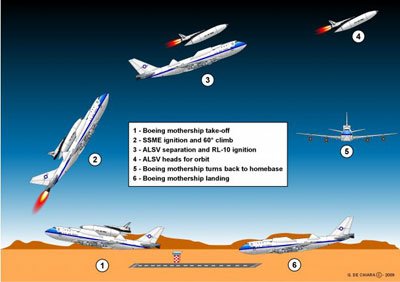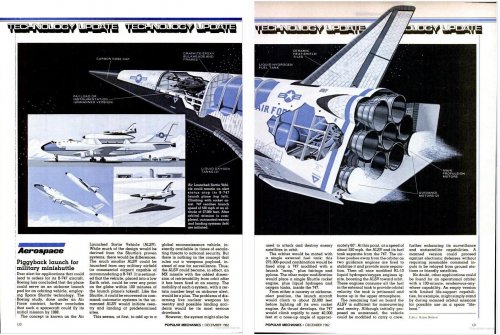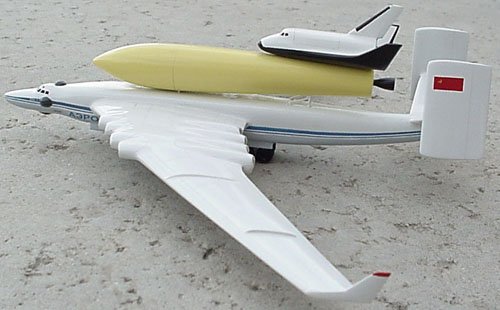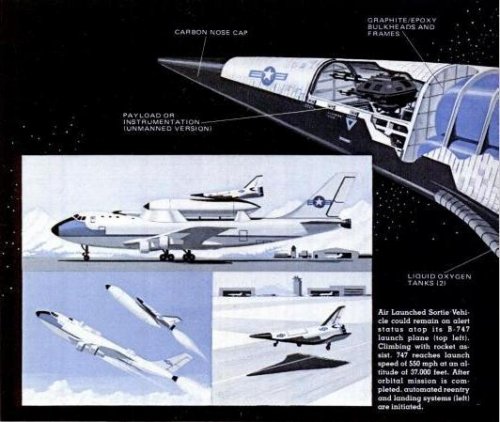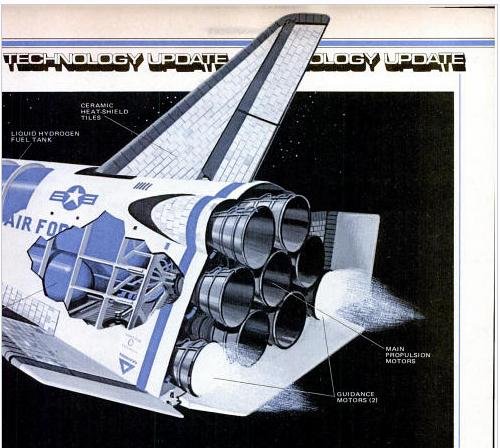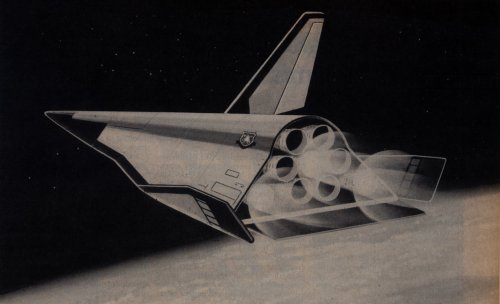You are using an out of date browser. It may not display this or other websites correctly.
You should upgrade or use an alternative browser.
You should upgrade or use an alternative browser.
AMSCI/ALSV - Air-launched mini shuttles from early 1980s
- Thread starter flateric
- Start date
XP67_Moonbat
ACCESS: Top Secret
- Joined
- 16 January 2008
- Messages
- 2,271
- Reaction score
- 541
Not neccessarily related. But here's some info on BETA.
http://www.secretprojects.co.uk/forum/index.php/topic,5217.0/highlight,beta+ii.html
Also, welcome aboard, bud.
Moonbat
http://www.secretprojects.co.uk/forum/index.php/topic,5217.0/highlight,beta+ii.html
Also, welcome aboard, bud.
Moonbat
- Joined
- 26 September 2008
- Messages
- 1,960
- Reaction score
- 746
Other than the fact that this was yet another proposal for an air-launched spacecraft, I don't know of any direct link. That does not mean that there is no direct link.
From what I have been able to determine, the ALSV study grew out of the USAF learning about some internal work at one or more aerospace companies. They wanted to know what was possible at the time. My data is pretty limited, but it appears at the USAF was only mildly interested, and once it became clear that this would still cost money because they had to replace the ET, the USAF lost interest.
Now the idea of air launch continued for awhile, and it still continues today in various forms. But it turns out that air launch does not provide a great increase in performance. The increase is only on the order of a very few percent (probably no more than 2-3 percent, I'm guessing). But there are other limitations, like the fact that if you get ready to launch and something goes wrong, you cannot simply recycle and try again, you probably have to return to base and try another day. (Other limitations include the size of the payload.) And so the question is if that small percentage increase is worth the other limitations.
From what I have been able to determine, the ALSV study grew out of the USAF learning about some internal work at one or more aerospace companies. They wanted to know what was possible at the time. My data is pretty limited, but it appears at the USAF was only mildly interested, and once it became clear that this would still cost money because they had to replace the ET, the USAF lost interest.
Now the idea of air launch continued for awhile, and it still continues today in various forms. But it turns out that air launch does not provide a great increase in performance. The increase is only on the order of a very few percent (probably no more than 2-3 percent, I'm guessing). But there are other limitations, like the fact that if you get ready to launch and something goes wrong, you cannot simply recycle and try again, you probably have to return to base and try another day. (Other limitations include the size of the payload.) And so the question is if that small percentage increase is worth the other limitations.
- Joined
- 26 September 2008
- Messages
- 1,960
- Reaction score
- 746
Here are some articles from Aviation Week in the early 1980s about the ALSV concept. The most useful is the one titled Space Sortie Viable. I also scanned three short articles on the ALSV.
These seem to largely have been generated by Boeing's work.
These seem to largely have been generated by Boeing's work.
Attachments
blackstar said:Now the idea of air launch continued for awhile, and it still continues today in various forms. But it turns out that air launch does not provide a great increase in performance. The increase is only on the order of a very few percent (probably no more than 2-3 percent, I'm guessing). But there are other limitations, like the fact that if you get ready to launch and something goes wrong, you cannot simply recycle and try again, you probably have to return to base and try another day. (Other limitations include the size of the payload.) And so the question is if that small percentage increase is worth the other limitations.
Well, there are other considerations than performance. You have more flexibility with inclination, weather, and launch windows because your launch site can move. Also, depending on the launcher and the launch vehicle, you can get away with "secret" launches, at least to some extent (you're hidden from ground observers, at least).
- Joined
- 26 September 2008
- Messages
- 1,960
- Reaction score
- 746
gtg947h said:Well, there are other considerations than performance. You have more flexibility with inclination, weather, and launch windows because your launch site can move. Also, depending on the launcher and the launch vehicle, you can get away with "secret" launches, at least to some extent (you're hidden from ground observers, at least).
Yes, all of those reasons have been cited in the past. But some of them may be overrated. For example, yes, you can get away from the weather. But is that going to be much better than simply waiting for better weather? And the aircraft itself has to be based somewhere, and that base can be subject to weather. You'd think that this would add flexibility, but the reality is that you still have to support the rocket and the payload, and that is done from fixed sites.
As for secret launches, this was indeed one of the reasons that air launch and submarine launch were considered for spysats in the early 1960s. There are a couple of drawbacks/negations. One is that the available payload is pretty limited, so you can do a secret launch, but you cannot put a lot into orbit. The other is that something in orbit can still be spotted, so you have to provide other low observable capabilities.
And I still think that the overall limitation remains the small payload size and mass. Air launch can provide some flexibility and some performance improvements, but they all tend to be marginal and they don't add up to much. The bottom line is that if this method was superior to ground launch, there would be more rockets that did this. Instead, we have been flying into space for over fifty years and only about three rockets (NOTSNIK, Pegasus, AirLaunch) have tried this approach, and only Pegasus became operational.
But man, I wish they had built that rocket to fly off a 747...
airrocket
Dreams To Reality
The main impediment to air launch is mostly mental and having balls to go do something that is not main-stream.
- Joined
- 6 August 2007
- Messages
- 3,883
- Reaction score
- 5,902
airrocket said:The main impediment to air launch is mostly mental and having balls to go do something that is not main-stream.
Apparently QC is a real impediment right now
http://www.aviationweek.com/aw/generic/story_generic.jsp?channel=aerospacedaily&id=news/asd/2010/03/24/02.xml
- Joined
- 26 September 2008
- Messages
- 1,960
- Reaction score
- 746
airrocket said:The main impediment to air launch is mostly mental and having balls to go do something that is not main-stream.
If the performance improvement was so obvious, somebody would have the courage to do it. But 50 years of spaceflight indicates that this just doesn't add up to a qualitative improvement.
FutureSpaceTourist
ACCESS: Top Secret
- Joined
- 10 March 2010
- Messages
- 590
- Reaction score
- 34
blackstar said:If the performance improvement was so obvious, somebody would have the courage to do it. But 50 years of spaceflight indicates that this just doesn't add up to a qualitative improvement.
Of course there have been a number of fully re-usable spaceplane HTHL TSTO designs/concepts over the years (although none were ever built
I assume though that the choice of aircraft came first - for perceived ease of re-usability etc - resulting in air-launch being used, rather than an expected significant performance gain from air-launch driving the use of aircraft?
blackstar said:If the performance improvement was so obvious, somebody would have the courage to do it. But 50 years of spaceflight indicates that this just doesn't add up to a qualitative improvement.
Keep in mind, though, that the USAF and NASA have proven largely incapable of seeing advanced projects through in recent decades. Those few that have been allowed to proceed have taken years, even decades, longer than originally planed, and gone vastly over budget.
- Joined
- 26 September 2008
- Messages
- 1,960
- Reaction score
- 746
FutureSpaceTourist said:blackstar said:If the performance improvement was so obvious, somebody would have the courage to do it. But 50 years of spaceflight indicates that this just doesn't add up to a qualitative improvement.
Of course there have been a number of fully re-usable spaceplane HTHL TSTO designs/concepts over the years (although none were ever built).
I assume though that the choice of aircraft came first - for perceived ease of re-usability etc - resulting in air-launch being used, rather than an expected significant performance gain from air-launch driving the use of aircraft?
Certainly designing a new aircraft would allow you to maximize the design. But I wonder what the real performance improvement would actually be. The most important thing needed is a bigger aircraft capable of lifting a bigger rocket. But it's not realistic to talk about aircraft significantly larger than those already available, like the 747 and C-5. Going much bigger makes it impossible to use existing runways, etc. And going more exotic, in terms of higher launch speeds and the like, undercuts one of the selling points of the approach, which is that it should be simpler.
But the primary impediment is cost. Big aircraft cost lots of money. The development cost for an aircraft bigger than a 747 is going to be in the billions of dollars.
quellish said:Apparently QC is a real impediment right now
http://www.aviationweek.com/aw/generic/story_generic.jsp?channel=aerospacedaily&id=news/asd/2010/03/24/02.xml
That isn't applicable to this topic, both the QC issue and the airlaunched targets.
XP67_Moonbat
ACCESS: Top Secret
- Joined
- 16 January 2008
- Messages
- 2,271
- Reaction score
- 541
Here's part 4 from Dwayne:
http://www.thespacereview.com/article/1608/1
Moonbat
http://www.thespacereview.com/article/1608/1
Moonbat
- Joined
- 26 September 2008
- Messages
- 1,960
- Reaction score
- 746
CFE said:Really enjoyed the series or articles so far. The new pic from Archipeppe is really tight!
Giuseppe and I have been working on this for a few months now. He has done drawings of the different variants.
The articles have resulted in several people who worked on these studies contacting me (at least 3-4, not all of whom have been very helpful, but may provide additional information). Unfortunately, none of them have any documents, although one has indicated that he may have some material on a 1982 era hard drive. What I would really like to see is anything that P&W actually delivered to the Air Force Rocket Propulsion Laboratory, but I'm not sure what part of the Air Force those records may have ended up in.
There's still a number of unknowns, like whether or not any of the companies (besides P&W and Boeing) did anything significant. Nobody bent any hardware, but did any of the other companies study this for anything more than a few weeks?
Next up, I'm going to look into the Teledyne-Ryan proposal from the late 1980s (referred to earlier in this thread) and then tie it into the Soviet MAKS proposal. One thing I want to answer is if the American studies, which were discussed in numerous American publications, inspired the Soviet MAKS.
I'm going to wrap all of these up into a print article for future publication. So I'm hoping that some of those sources still come through for me.
archipeppe
ACCESS: Top Secret
- Joined
- 18 October 2007
- Messages
- 2,431
- Reaction score
- 3,149
CFE said:Really enjoyed the series or articles so far. The new pic from Archipeppe is really tight!
This set of drawings was done in exclusive for Dwayne's articles.
blackstar said:I'm going to wrap all of these up into a print article for future publication.
I'll be interested to see that. As can be seen from the drawings much earlier in the thread, I've long wanted to do my own article on the program. I've got quite a number of documents... P&W, Rockwell, Boeing, etc. ... but no personal interviews.
XP67_Moonbat
ACCESS: Top Secret
- Joined
- 16 January 2008
- Messages
- 2,271
- Reaction score
- 541
Scott, Dwayne,
I think you guys should do a collabo on a special APR regarding this topic. Toss in the artwork from Giuseppe and I'm sold. I'm standing by and ready to buy it if you guys assemble it.
Oh, and Scott, if you're ready to put out the GRM-29A article, I'm ready to buy it.
Unless the good Professor Czsyz has more to add to that, of course.
I stand ready.
Moonbat
I think you guys should do a collabo on a special APR regarding this topic. Toss in the artwork from Giuseppe and I'm sold. I'm standing by and ready to buy it if you guys assemble it.
Oh, and Scott, if you're ready to put out the GRM-29A article, I'm ready to buy it.
Unless the good Professor Czsyz has more to add to that, of course.
I stand ready.
Moonbat
XP67_Moonbat
ACCESS: Top Secret
- Joined
- 16 January 2008
- Messages
- 2,271
- Reaction score
- 541
Guys,
I had a little flashback from my childhood today, called up Google, and voila. PopSci from Dec, 1982. Go to PAGE 120.
http://books.google.com/books?id=-9kDAAAAMBAJ&printsec=frontcover&dq=ALSV+Popular+Science+1982&source=bl&ots=GQEzknjeef&sig=KeC5G9hW-my1U5vDPgqb-G8VQD0&hl=en&ei=hWLOS93fPIbkNZmOuPwP&sa=X&oi=book_result&ct=result&resnum=6&ved=0CCUQ6AEwBQ#v=onepage&q&f=false
If somebody can isolate just the article, that'd be awesome. Thanks.
Moonbat
I had a little flashback from my childhood today, called up Google, and voila. PopSci from Dec, 1982. Go to PAGE 120.
http://books.google.com/books?id=-9kDAAAAMBAJ&printsec=frontcover&dq=ALSV+Popular+Science+1982&source=bl&ots=GQEzknjeef&sig=KeC5G9hW-my1U5vDPgqb-G8VQD0&hl=en&ei=hWLOS93fPIbkNZmOuPwP&sa=X&oi=book_result&ct=result&resnum=6&ved=0CCUQ6AEwBQ#v=onepage&q&f=false
If somebody can isolate just the article, that'd be awesome. Thanks.
Moonbat
XP67_Moonbat said:If somebody can isolate just the article, that'd be awesome. Thanks.
I'm at a loss as to how to save the damned thing.
archipeppe
ACCESS: Top Secret
- Joined
- 18 October 2007
- Messages
- 2,431
- Reaction score
- 3,149
RobertWL said:Hopefully this isn't against the rules but.. This is my shot at isolating the article. Didn't turn out too bad.
Great find Robert!!!!!!
RobertWL said:Hopefully this isn't against the rules but..
Can't see how it could be. It would be one thing to scan an article yourself and post it... it's another when the article was scanned and posted online for free with the full consent of the publisher. Once they've done that, it's hard to see how there'd be a problem in making it available directly.
XP67_Moonbat
ACCESS: Top Secret
- Joined
- 16 January 2008
- Messages
- 2,271
- Reaction score
- 541
Thanks Robert! 
RobertWL
ACCESS: Restricted
- Joined
- 28 January 2007
- Messages
- 46
- Reaction score
- 23
Perhaps, But tis good to be careful none the less. Though on a side note, If they've put all their issues online perhaps now I can finally clear some space out of that bedroom.. Nah!
P.S IF anyone else needs articles like that copied, lemme know.
P.S IF anyone else needs articles like that copied, lemme know.
- Joined
- 26 September 2008
- Messages
- 1,960
- Reaction score
- 746
XP67_Moonbat said:Guys,
I had a little flashback from my childhood today, called up Google, and voila. PopSci from Dec, 1982. Go to PAGE 120.
They probably wrote this based upon the Aviation Week article that had appeared in November. Alternatively, both AWST and PopSci got the same press packet from Pratt & Whitney. Alas, there's nothing in this article other than the artwork that had not already appeared in Aviation Week earlier in the year. The artwork itself is a direct copy of stuff produced by the company.
XP67_Moonbat
ACCESS: Top Secret
- Joined
- 16 January 2008
- Messages
- 2,271
- Reaction score
- 541
Dwayne,
I'd love to get my hands on that press packet.
At Robert, I just posted similar link over in the "Boeing OTV" thread regarding aerobraking. Nice article.
I'd love to get my hands on that press packet.
At Robert, I just posted similar link over in the "Boeing OTV" thread regarding aerobraking. Nice article.
FutureSpaceTourist
ACCESS: Top Secret
- Joined
- 10 March 2010
- Messages
- 590
- Reaction score
- 34
Would I be correct in assuming that the Myasishchev 3M2-5 is the Russian (Soviet) equivalent of the ALSV?
Is there any more published material about this? (preferably in English!)
Is there any more published material about this? (preferably in English!)
Attachments
FutureSpaceTourist
ACCESS: Top Secret
- Joined
- 10 March 2010
- Messages
- 590
- Reaction score
- 34
Thanks for the MAKS pointer, found the info in the MAKS-OS thread http://www.secretprojects.co.uk/forum/index.php/topic,6654.0.
FutureSpaceTourist
ACCESS: Top Secret
- Joined
- 10 March 2010
- Messages
- 590
- Reaction score
- 34
The little I've found on MAKS origins is now captured in http://www.secretprojects.co.uk/forum/index.php/topic,6654.msg92133.html#msg92133.
- Joined
- 26 September 2008
- Messages
- 1,960
- Reaction score
- 746
FutureSpaceTourist said:The little I've found on MAKS origins is now captured in http://www.secretprojects.co.uk/forum/index.php/topic,6654.msg92133.html#msg92133.
Actually, if you look earlier in this thread (I'm too lazy to do it at the moment) you'll find several links to the buran.ru site. On that site there are at least a half dozen English-language versions of Russian technical papers on MAKS. One of them describes the multiple variants that they considered (manned, unmanned, Mir-resupply, cargo container). I think there's also one on engines and a few others that are rather esoteric. I have not gone through them carefully, so I haven't yet answered my question on the origins. I seem to remember that the overview document was missing some key details, such as when it started and who was pushing it, etc.
FutureSpaceTourist
ACCESS: Top Secret
- Joined
- 10 March 2010
- Messages
- 590
- Reaction score
- 34
blackstar said:On that site there are at least a half dozen English-language versions of Russian technical papers on MAKS.
[...]
I have not gone through them carefully, so I haven't yet answered my question on the origins. I seem to remember that the overview document was missing some key details, such as when it started and who was pushing it, etc.
Yes I followed that link and looked at a few of the (non-esoteric) reports. As you say they talk about the systems/planes and not the programmes. So as I couldn't find anything useful on origins I didn't bother mentioning them!
- Joined
- 26 May 2006
- Messages
- 34,867
- Reaction score
- 15,729
Hi,
a very strange space shuttle carrier aircraft,it was the Boeing
Model-747 with anther fifth rocket engine,mounted at the rear
of its fuselage;
http://books.google.com.eg/books?id=-9kDAAAAMBAJ&pg=PA130&dq=FIGHTER-BOMBER+EXPERIMENTAL+AIRCRAFT&hl=ar&ei=VccrTOCfLtWVOLHUgJEJ&sa=X&oi=book_result&ct=result&resnum=36&ved=0CNQBEOgBMCM#v=onepage&q&f=true
a very strange space shuttle carrier aircraft,it was the Boeing
Model-747 with anther fifth rocket engine,mounted at the rear
of its fuselage;
http://books.google.com.eg/books?id=-9kDAAAAMBAJ&pg=PA130&dq=FIGHTER-BOMBER+EXPERIMENTAL+AIRCRAFT&hl=ar&ei=VccrTOCfLtWVOLHUgJEJ&sa=X&oi=book_result&ct=result&resnum=36&ved=0CNQBEOgBMCM#v=onepage&q&f=true
Attachments
FutureSpaceTourist
ACCESS: Top Secret
- Joined
- 10 March 2010
- Messages
- 590
- Reaction score
- 34
hesham said:a very strange space shuttle carrier aircraft,it was the Boeing
Model-747 with anther fifth rocket engine,mounted at the rear
of its fuselage
I don't think it's that unusual as a proposed way for the carrier aircraft to pitch up prior to separation, so that the space vehicle doesn't have to make a 90-odd degree turn to the vertical.
See both the quoted text and first picture in http://www.secretprojects.co.uk/forum/index.php/topic,295.msg92417.html#msg92417 for one discussion of this. I'm fairly certain I've seen other mentions elsewhere on SPF - don't have time to search for them right know (and hopefully someone else has a better memory than me!).
- Joined
- 26 September 2008
- Messages
- 1,960
- Reaction score
- 746
FutureSpaceTourist said:I don't think it's that unusual as a proposed way for the carrier aircraft to pitch up prior to separation, so that the space vehicle doesn't have to make a 90-odd degree turn to the vertical.
See both the quoted text and first picture in http://www.secretprojects.co.uk/forum/index.php/topic,295.msg92417.html#msg92417 for one discussion of this. I'm fairly certain I've seen other mentions elsewhere on SPF - don't have time to search for them right know (and hopefully someone else has a better memory than me!).
Actually, it was to enable the carrier aircraft to achieve sufficient altitude. And if you read earlier in the thread, as well as the various links, you'll find all the mentions you need.
Matej
Multiuniversal creator
http://forum.nasaspaceflight.com/index.php?topic=18949.0
There is also the AIAA-83-1188 paper posted.
Another article:
http://www.thespacereview.com/article/1569/1
http://www.thespacereview.com/article/1580/1
http://www.thespacereview.com/article/1591/1
http://www.thespacereview.com/article/1608/1
There is also the AIAA-83-1188 paper posted.
Another article:
http://www.thespacereview.com/article/1569/1
http://www.thespacereview.com/article/1580/1
http://www.thespacereview.com/article/1591/1
http://www.thespacereview.com/article/1608/1
Attachments
Similar threads
-
Looking for old AWST with articles on soviet military space program
- Started by flateric
- Replies: 12
-
Early US ATF Projects- references
- Started by overscan (PaulMM)
- Replies: 48
-
-
Top Secret DAMON: the classified reconnaissance payload planned for the fourth space shuttle mission
- Started by Flyaway
- Replies: 1
-
Rockwell International MRCC (Multi Role Common Core) TAV
- Started by flateric
- Replies: 24

